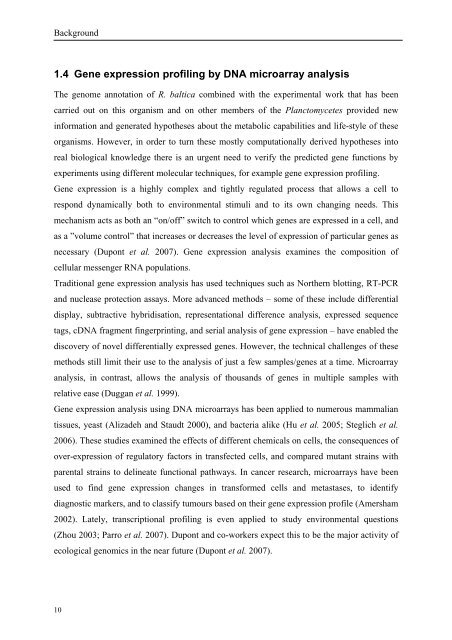a Whole Genome Array Approach - Jacobs University
a Whole Genome Array Approach - Jacobs University
a Whole Genome Array Approach - Jacobs University
You also want an ePaper? Increase the reach of your titles
YUMPU automatically turns print PDFs into web optimized ePapers that Google loves.
Background<br />
1.4 Gene expression profiling by DNA microarray analysis<br />
The genome annotation of R. baltica combined with the experimental work that has been<br />
carried out on this organism and on other members of the Planctomycetes provided new<br />
information and generated hypotheses about the metabolic capabilities and life-style of these<br />
organisms. However, in order to turn these mostly computationally derived hypotheses into<br />
real biological knowledge there is an urgent need to verify the predicted gene functions by<br />
experiments using different molecular techniques, for example gene expression profiling.<br />
Gene expression is a highly complex and tightly regulated process that allows a cell to<br />
respond dynamically both to environmental stimuli and to its own changing needs. This<br />
mechanism acts as both an “on/off” switch to control which genes are expressed in a cell, and<br />
as a ”volume control” that increases or decreases the level of expression of particular genes as<br />
necessary (Dupont et al. 2007). Gene expression analysis examines the composition of<br />
cellular messenger RNA populations.<br />
Traditional gene expression analysis has used techniques such as Northern blotting, RT-PCR<br />
and nuclease protection assays. More advanced methods – some of these include differential<br />
display, subtractive hybridisation, representational difference analysis, expressed sequence<br />
tags, cDNA fragment fingerprinting, and serial analysis of gene expression – have enabled the<br />
discovery of novel differentially expressed genes. However, the technical challenges of these<br />
methods still limit their use to the analysis of just a few samples/genes at a time. Microarray<br />
analysis, in contrast, allows the analysis of thousands of genes in multiple samples with<br />
relative ease (Duggan et al. 1999).<br />
Gene expression analysis using DNA microarrays has been applied to numerous mammalian<br />
tissues, yeast (Alizadeh and Staudt 2000), and bacteria alike (Hu et al. 2005; Steglich et al.<br />
2006). These studies examined the effects of different chemicals on cells, the consequences of<br />
over-expression of regulatory factors in transfected cells, and compared mutant strains with<br />
parental strains to delineate functional pathways. In cancer research, microarrays have been<br />
used to find gene expression changes in transformed cells and metastases, to identify<br />
diagnostic markers, and to classify tumours based on their gene expression profile (Amersham<br />
2002). Lately, transcriptional profiling is even applied to study environmental questions<br />
(Zhou 2003; Parro et al. 2007). Dupont and co-workers expect this to be the major activity of<br />
ecological genomics in the near future (Dupont et al. 2007).<br />
10

















